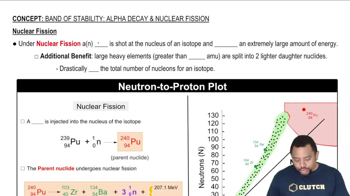Iodine-131 is a convenient radioisotope to monitor thyroid activity in humans. It is a beta emitter with a half-life of 8.02 days. The thyroid is the only gland in the body that uses iodine. A person undergoing a test of thyroid activity drinks a solution of NaI, in which only a small fraction of the iodide is radioactive. b. A normal thyroid will take up about 12% of the ingested iodide in a few hours. How long will it take for the radioactive iodide taken up and held by the thyroid to decay to 0.01% of the original amount?
Ch.21 - Nuclear Chemistry

Brown15th EditionChemistry: The Central ScienceISBN: 9780137542970Not the one you use?Change textbook
Chapter 21, Problem 58
Which of the following statements about the uranium used in nuclear reactors is or are true? (i) Natural uranium has too little 235U to be used as a fuel. (ii) 238U cannot be used as a fuel because it forms a supercritical mass too easily. (iii) To be used as fuel, uranium must be enriched so that it is more than 50% 235U in composition. (iv) The neutron-induced fission of 235U releases more neutrons per nucleus than the fission of 238U.
 Verified step by step guidance
Verified step by step guidance1
Step 1: Understand the composition of natural uranium. Natural uranium consists mostly of two isotopes: 238U and 235U. The isotope 235U is fissile, meaning it can sustain a nuclear chain reaction, but it is only about 0.7% of natural uranium.
Step 2: Evaluate statement (i). Natural uranium has too little 235U to be used as a fuel. This statement is true because the concentration of 235U in natural uranium is too low to sustain a chain reaction in most nuclear reactors without enrichment.
Step 3: Evaluate statement (ii). 238U cannot be used as a fuel because it forms a supercritical mass too easily. This statement is false. 238U is not fissile and does not form a supercritical mass easily. Instead, it is fertile, meaning it can be converted into a fissile material (239Pu) in a reactor.
Step 4: Evaluate statement (iii). To be used as fuel, uranium must be enriched so that it is more than 50% 235U in composition. This statement is false. For most nuclear reactors, uranium is enriched to about 3-5% 235U, not more than 50%.
Step 5: Evaluate statement (iv). The neutron-induced fission of 235U releases more neutrons per nucleus than the fission of 238U. This statement is true. The fission of 235U typically releases more neutrons, which is crucial for sustaining a chain reaction.
Key Concepts
Here are the essential concepts you must grasp in order to answer the question correctly.
Uranium Isotopes
Uranium exists primarily in two isotopes: U-235 and U-238. U-235 is fissile, meaning it can sustain a nuclear chain reaction, while U-238 is not directly usable as fuel in most reactors. Natural uranium contains about 0.7% U-235, which is insufficient for most nuclear reactors, necessitating enrichment to increase the proportion of U-235.
Recommended video:
Guided course

Isotopes
Nuclear Enrichment
Nuclear enrichment is the process of increasing the percentage of U-235 in uranium. For most reactors, uranium must be enriched to about 3-5% U-235, not over 50% as stated in the question. Enrichment allows for a more efficient fission reaction, enabling the uranium to be used effectively as fuel in nuclear reactors.
Recommended video:
Guided course

Nuclear Binding Energy
Neutron-Induced Fission
Neutron-induced fission occurs when a neutron collides with a nucleus, causing it to split and release energy, along with additional neutrons. U-235 releases more neutrons per fission event compared to U-238, which is crucial for sustaining a chain reaction in nuclear reactors. This property makes U-235 a preferred fuel for nuclear energy production.
Recommended video:
Guided course

Band of Stability: Nuclear Fission
Related Practice
Textbook Question
Textbook Question
Why is it important that radioisotopes used as diagnostic tools in nuclear medicine produce gamma radiation when they decay? Why are alpha emitters not used as diagnostic tools?
Textbook Question
(c) What other substances are used as a moderator in nuclear reactor designs?
1
views
Textbook Question
Complete and balance the nuclear equations for the following fission or fusion reactions:
(a) 21H + 21H → 32He + _
(b) 23992U + 10n¡ → 13351Sb + 9841Nb + _ 10n
1
views
